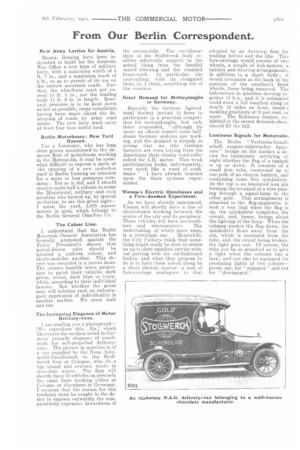From Our Berlin Correspondent.
Page 17

If you've noticed an error in this article please click here to report it so we can fix it.
New Army Lorries for Austria.
Messrs. Bussing have been instructed to build for the Austrian War Office a new type of military lorry, with a maximum width of 6 ft. 7 in., and a maximum track of 5 ft., so as to permit of its use on the narrow mountain roads. Further, the wheelbase must not exceed 14 ft. 8 in., nor the loading body 11 ft. 9 in. in length. Rearaxle pressure is to be kept down as low as possible, many complaints having been made about the destroying of roads by army road trains. The new lorry must carry at least four tons useful load.
Berlin Motorbuses: New Yard Opened.
For a Londoner, who has long since grown accustomed to the immense fleet of motorbuses working in the Metropolis, it may be somewhat difficult to repress a smile at. the opening of a new motorbus yard in Berlin forming an occasion for a more or less pompous ceremony. Yet so it, did, and I should require quite half a column to name the Ministerial, military and civic notables who turned up, by special invitation, to see this great sight— I mean the yard, 2,679 square metres in area, which belongs to the Berlin General Omnibus Co.
The Colour Line.
I understand that the Berlin Motoreab Owners' Association has formally protested against the Police President's decree that petrol-driven cabs should be painted a uniform colour, and electromobiles another, This decree was recorded in a recent issue. The owners humbly crave permission to paint their vehicles dark green, cerise, dark blue or ivorywhite, according to their individual fancies. But whether the great man will tolerate such an extravagant expression of individuality is another matter. We must wait and see.
The Increasing Elegance of Motor Delivery-vans.
T am n sending you a photograph— [We reproduce this.— ED.] which illustrates the modern trend in Germany towards elegance of coachwork for self-propelled deliveryvans. The picture in question is of a van supplied by the Neue Automobil-Gesellschaft to the Stollwerck firm at Cologne, who do a big inland and oversea trade in chocolate wares. The firm will shortly have 10 vehicles on precisely the same lines working either at Cologne or elsewhere in Germany. suppose that the reason for this tendency must be sought in the desire to express outwardly the comparatively expensive inwardness of
the automobile. The curvilinear style of the Stollwerck body receives admirable support in the. actual thing from the fanciful raised lettering and the rounded brass-work. In particular, the roof-railing, with its elongated links, is, I think, something out of the COMI11011.
Great Demand lor Motoreloughs in Germany.
Recently the Uerinan Agricultural Society invited 12 firms to participate in a practical competition for motorploughs, but only three responded, although (to quote an official report) some halfdozen German systems are working, and the demand is already so strong that we (the German farmers) are even buying from the Americans their clumsy road-roller called the 1.11. motor. This weak participation looks, unfortunately, very much like a want of confidence." I have already touched upon the three systems represented.
Vienna's Electric Omnibuses and a Fore-doomed Experiment.
As we have already announced, Vienna will shortly have a line of electrobuses working between the centre of the city and its periphery. These vehicles will have accumulators and electromotors. The undertaking, of which more anon, is a municipal one. Meanwhile, the City Fathers think that something might really be done to create an up-to-date omnibus service without parting with the old-fashioned bodies, and what they propose to do is to have them towed along by a short electric tractor— a sort of fore-carriage analogous to that
adopted by an Antwerp firm for trailing lorries and the like. This fore-carriage would consist of two wheels, a couple of hub-motors, a battery and steering arrangements, in addition to a short body ; it would terminate at the back in the position of the omnibus's front wheels, these being removed. The hub-motors in question develop together 11 It.p., and it is estimated could draw a full omnibus along at nearly 10 miles an hour, besides tackling gradients of 10 per cent. or more. The Robinson tractor, exhibited at the recent Brussels show, should fill the bill.
Luminous Signals for Motorcabs.
The Berlin " Vertriebs-Gesellschaft magnet-elektrischer Apparate " brings on the market a device for luminously notifying at night whether the flag of a taxicab is up or down. It consists of a small iron tube, connected up to one pole of an electric battery, and containing some free quicksilver. At the top is an insulated iron pin forming the terminal of a wire passing through a signal-lamp to the other pole. This arrangement is attached to the flag-apparatus in such a way that when the flag is up, the quicksilver completes the circuit, and, hence, brings about the lighting of the lamp. When the cabman pushes the flag down, the quicksilver flows away from the pin, which is insulated from the tube, and, the circuit being broken, the light goes out. Of course, the tube can he so attached as to give a light when the cabman has a fare ; and can also he equipped for producing lights of two colours-green, say, for " engaged " and red for "disengaged."






















